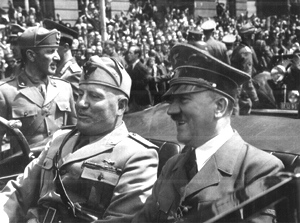“It hadn’t been easy to guess what it was that Mussolini really meant to do…It wasn’t merely an attempt to rid the state and its appendages from the influence of ‘untrustworthy” individuals: what lay in wait for us was the destruction of our way of life, of our very existence, the absolute and indiscriminate destruction of our world.”
In 1967, an u nnamed writer begins writing a long letter to an unknown recipient in Italy, a letter he knows will take weeks, if not months to conclude. The writer’s references to the Six Day War and to the fact that “here most of the people have no past and no one is surprised” quickly establish the letter writer’s home as Israel, but there are no clues about the person being addressed. Writing from Tel Aviv, the narrator reconstructs that time in his life “before Israel,” when he lived in Rome and where his parents owned the Albergo della Magnolia, an elegant hotel.
nnamed writer begins writing a long letter to an unknown recipient in Italy, a letter he knows will take weeks, if not months to conclude. The writer’s references to the Six Day War and to the fact that “here most of the people have no past and no one is surprised” quickly establish the letter writer’s home as Israel, but there are no clues about the person being addressed. Writing from Tel Aviv, the narrator reconstructs that time in his life “before Israel,” when he lived in Rome and where his parents owned the Albergo della Magnolia, an elegant hotel.
In a straightforward, conversational style, the writer describes himself as a shy, serious student whose extracurricular life has always revolved around the Albergo della Magnolia. In 1929, when he is in his early twenties, he is on duty for New Year’s Eve at the hotel when beautiful, young Sonia Gentile falls and breaks her leg at a party there. During her recuperation, Sonia receives the writer’s special attention, and it is not long before they are in love. Sonia has grown up under fascism as the daughter of a wealthy banker who supports Mussolini’s policies and profits from them, and her family is devoutly Catholic. The speaker, whom we learn is Dino Carpi, has been only a “twice a year Jew,” on Yom Kippur and Passover, and he ignores the then-unimportant cultural differences to pursue his love of Sonia. His family is comfortable and well respected, and he is anxious to be accepted by her family, even denying his own culture toward that end.

As Dino writes about the ensuing ten years, he moves from the promise of the 1929 New Year through the “funereal year” of 1938, addressing and bringing alive the step by step process by which Mussolini and the fascists appeal to an inherent Italian bias against Jews and bring about their total isolation from Italian life. The plain, unadorned narrative achieves its power from its simplicity—its seeming logic—and from the naivete of the love-blinded characters, as one ominous fascist declaration after another is glossed over, no one believing that such policies are really as draconian as they may appear. As polite handshakes give way to salutes, Levi explores the love story of Sonia and Dino, but when in 1938, the government issues the Manifesto of Racist Scientists, in which a “pure Italian race” is lauded—and Jews “do not belong to the Italian race”—the inevitability of the fascist goals are obviously clear.
 A census in which every resident must indicate his race, the declaration that Jewish students cannot attend public schools, a new law prohibiting Jews from owning property worth more than a certain amount and forbidding of Jews from running businesses, inevitably change the fabric of the society, but the change is gradual and for most of the characters, all of whom are engaged in active everyday lives, the long-term impact is not fully grasped. The love of Sonia and Dino is increasingly tested by political forces, and their families begin to exert ever more pressure on their relationship.
A census in which every resident must indicate his race, the declaration that Jewish students cannot attend public schools, a new law prohibiting Jews from owning property worth more than a certain amount and forbidding of Jews from running businesses, inevitably change the fabric of the society, but the change is gradual and for most of the characters, all of whom are engaged in active everyday lives, the long-term impact is not fully grasped. The love of Sonia and Dino is increasingly tested by political forces, and their families begin to exert ever more pressure on their relationship.
Author Lia Levi succeeds in creating enormous sympathy for her protagonists, in part because the threats to their safety occur so gradually, completely caught up, as they are, in their own daily lives. The conclusion, however, is stunning, powerful despite its inevitability, simply because the protagonists did not expect it or believe it, despite all the warnings. And though the reader also knows, from history, what the outcome will be, it is impossible not to hope for a different result because the characters deserve better. The last pages, which resolve any questions the reader may have, are poignant for the feelings they reveal by and about the characters and for the sympathy they inspire in the reader. Filled with wonderfully observed descriptions, this deliberately simple story is all the more powerful for its clarity and its unambiguous presentation of everyday life in pre-war Italy, a subject which has received little literary attention.
Notes: The author’s photo and an interview by Paola Sergi appear on http://www.belletrista.com
The photo of Benito Mussolini with Adolf Hitler, from the National Archives, appears on http://www.emersonkent.com
A copy of the odious Manifesto of Racist Scientists may be read in Italian and English on http://users.dickinson.edu
